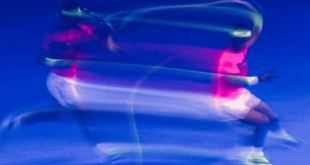BERLIN — “As far apart as you are on a tennis court, you can actually feel the other one very intimately.”
The Athletic is sitting courtside in Berlin at the Laver Cup next to Andre Agassi, as he explains the rhythms and dynamics of the sport he once conquered. Agassi won eight Grand Slam titles in an illustrious career, before withdrawing from a sport that took him to the edge and which, in his seminal autobiography Open, he admitted to often hating.
Since retiring in 2006, Agassi has largely kept away from tennis. But from next year he will captain Team World at the annual exhibition event, established by Roger Federer and his sports and entertainment company Team8 in 2017. It has designs on being the tennis version of golf’s Ryder Cup, which chairman Tony Godsick — also Federer’s agent — admitted this week “has a 90-year head start on us”.
Agassi will be up against Team Europe and its incoming captain Yannick Noah from 2025; Noah is replacing Bjorn Borg. Agassi, who is replacing John McEnroe, is in Germany to get a feel for the environment of the tournament, which will next year move to San Francisco.
“Do you want to just nerd out about tennis or talk about anything else?” Agassi asks soon after we begin. But when he talks, it tends to be both at once. When asked how important understanding the psychology of a player is, Agassi responds: “It’s not what you say, it’s what somebody hears.
“In life and in relationships.”
This is how to watch a tennis match through Agassi’s eyes, as Grigor Dimitrov and Alejandro Tabilo battle in Berlin.

GO DEEPER
60 minutes and 14 years: A Manhattan drive out of the tennis wilderness with Andre Agassi
Having spent much of his retirement in Las Vegas with his family — 22-time major champion Steffi Graf, and their two children, Jaden and Jaz — Agassi, 54, has made a tentative return to wider public life this year.
Tennis-wise, his role as a Laver Cup team captain will arguably be his most significant in the sport since retiring — he has coached Dimitrov and Novak Djokovic in spells.
He plans to be in communication with the Team World players all year round, arguing that even for a one-off exhibition tournament, the principles of coaching should not change.
“Just parachuting into someone’s life for one week is not going to create buy in,” he says.
“I’m looking forward to interacting with the guys throughout the year and getting that level of understanding, through the learning I do, and the trust you earn.”
As Dimitrov and Tabilo prepare to get under way, Agassi explains how he will approach his captaincy role.
“Some of the players I know well and we’re in communication anyhow,” he says, with three key members of the Team World cohort being fellow Americans Taylor Fritz, Frances Tiafoe and Ben Shelton.
“I can’t help but watch someone’s game and first of all put myself in the skin of their opponent and think, ‘What would I do against this guy?’ and work my way back from there.”

Andre Agassi (middle, right) with fellow incoming Laver Cup captain Yannick Noah (middle, left), flanked by Bjorn Borg (left) and John McEnroe (right) (Clive Brunskill/Getty Images for Laver Cup)
The match starts, and a few things become clear about how Agassi watches tennis. Throughout his career, he was regarded as having one of tennis’s sharpest analytical brains — a supreme returner seemingly able to read the mind of his opponents. Most famously, he was able to anticipate where Boris Becker, who possessed one of the most lethal serves on tour, would aim from the way that the German’s tongue would curl out to the side, pointing where his serve was about to go. Agassi ended his career with a 10-4 winning record against him.
Appropriately enough for a Las Vegas inhabitant, his analysis starts with a casino analogy — that of one player being the house and the other being the gambler.
“My whole objective when I was playing was to be the 51 per cent,” he says.
“If somebody has a fundamental advantage then they’re the house, and the other person’s the gambler,” Agassi explains. “Tennis is all about trying to make sure you can control the match without doing anything too special. Playing up here (he raises his hands) is not where you want to be.
You don’t want to be the one hitting on 16 if you’re playing Black Jack. The dealer doesn’t have to hit on 16.”
Logic says that Dimitrov, the higher-ranked player (No. 10 to No. 22) playing on a surface he favours, would consider himself the house. Were this on clay, Tabilo would probably consider himself the house.
“If the gambler plays smart and they’re good with their money management then they can create a better chance of winning,” Agassi says. Then it’s time for him to demonstrate that trademark serve clairvoyance — which he plays down.
Both players start the match serving big, but Agassi correctly guesses where a few of their deliveries are going to go.
“I didn’t have an amazing ability, I had a sensibility,” he says.
“Certain times the players had tells. But more than anything you have a sensibility so you can pretty much guess. I’m guessing a hell of a lot closer to 75 per cent than 50 per cent.
“You know what their most viable serve is in the biggest moments, when they’re going to go for it as their default. In a lot of cases, players have more confidence in their biggest serves, but not at the biggest moments. Going for a big serve at 30-0 doesn’t tell me anything.
“A big serve down the T at a big moment would communicate a different narrative — ‘You need to know I believe in this’. It’s like a poker hand — there’s a narrative and the second you depart, you’re telling your opponent you don’t believe in it.”
Agassi then introduces another concept: the “meat and potatoes” of a match.

Alejandro Tabilo (sitting) gets advice between games (Maja Hitij / Getty Images for Laver Cup)
After Tabilo hits an effective drop shot, Agassi explains that his meat and potatoes is dominating from the back of the court and stopping Dimitrov from being proactive. The drop shot is the disruptive counterpoint that keeps Dimitrov thinking.
In the next game, serving down 1-2, Dimitrov gives an indication of his meat and potatoes. “Decent serve, controlled aggression and then he comes forward and all of a sudden locks down the point,” Agassi says as Dimitrov moves up 15-0.
Agassi’s warming up now, starting to feel the rhythms of the match.
Dimitrov goes down a break point, saving it with a lucky net cord off a backhand. He then brings up game point, and looks keen to get this done and escape with a hold for 2-2.
“OK, second serve, best case would be forehand body serve to give yourself some margin.”
“Make him take a swing at it.”


Dimitrov does exactly that and wins the point. “Yep,” Agassi says, in one of many moments of clairvoyance.
“He went, ‘I know you need to be aggressive. Your backhand is a shorter swing, so maybe you can direct the second serve. The forehand you have to put a cut on it and the ball’s low coming through. I’m going to put a big target on it which I know I’m going to make. I want to get out of this game and you’re going to have to put a clean cut on it.’”
Agassi starts to take the temperature of the players and the room. “Grigor’s going to calm down.
“He’s played four games, he’s settled emotionally, the blood pressure has come down. He’s got a feel for where he can hurt him and where he can’t. Grigor should use the scoreboard to do some prodding, be a bit nastier with his slice.
“Let him know he has another gear to go to. Let him know he better keep stressing out. Try and make him feel like he’s going to have to go up another level.”

GO DEEPER
‘One of the worst things’: How Grigor Dimitrov shook off ‘Baby Fed’ label to find himself
When Tabilo holds for 3-2, Agassi imagines himself in his role of captain next year. “It’s about taking risks but not always feeling like he has to take that risk,” he says.
“When I was doing my job well, I would never feel the pressure at 2-3, I would be telling myself I’m going to tell this story, and it’s only when this story stops working that I have a big decision to make.
How do players make that decision? What can you do for instance if up against an opponent who’s dominating with their serve?
“A bigger serve doesn’t mean anything if you’re holding serve (yourself),” Agassi says, busting one of tennis’s great myths in 10 words.
“Your narrative then becomes more important at certain times. When I played a huge server like (Ivo) Karlovic, the first two points on my serve had a lot of urgency. If you’re playing someone where you know you’re going to get a lot of chances, I can treat those first two points with purpose, but less urgency.”
After a big point with Dimitrov serving at 4-3 and both players — and the capacity crowd — pumped up, things turn to the impact of teammates and captains on the sidelines — a rarity in one of the most isolating sports there is.

Grigor Dimitrov fed off the energy of his teammates on the side of the court (Clive Brunskill / Getty Images for the Laver Cup)
“I think some people from team sports envy the destiny of an individual sport,” Agassi says, but a player who won 30 of 36 Davis Cup matches in helping the USA to three titles can also see the value in camaraderie.
“I felt like if I was connected to something bigger than me then I could always get 100 per cent out of myself.
“A lot of times in my life it was easier to care more about others than myself.”
We’re level at 4-4, and Tabilo continues to serve big, giving Dimitrov little to work with. Both players are playing with a high first-serve percentage, which Agassi correctly intuits as around 70 per cent for Tabilo (it ends up at 72 per cent for the first set).
“As a returner, you tell yourself he’s serving big but he’s catching some edges.”
Dimitrov makes a few returns, though, and we’re at deuce. Typical tennis.
“Suddenly it feels like you’re swimming upstream,” Agassi says. “It’s like a staring contest.”
At 4-4, deuce, we’re at the tensest point of the match so far. What would Agassi do if returning right now?
“There’s no way he’s going to beat me down the centre and I’m not going to be late.
“My return was different. I play with two hands, I would have banged that thing, are you kidding. I’m not saying I’m better than these guys but if I’m ready for a serve and it comes to where I anticipate, my intention was to hurt.”
Tabilo does indeed go down the centre, which Dimitrov anticipates but can’t make a return.




Dimitrov gets to deuce again, but misses the return again too. The cliche is that a player should feel better after a missed chance if they know they’ve done the right thing. Agassi shoots down.
“It’s more frustrating when you know what’s going to happen, you stacked the deck and it’s played out how you want but you don’t execute,” he says.
That doesn’t mean Dimitrov should stop believing in himself as the “house” in the match.
“It washes out,” Agassi says. “The house loses money in certain hands.”
At the change of ends, Captain Agassi takes over again. “I’m saying to Grigor, ‘Get back to controlled 85 per cent aggression. Don’t get ahead of yourself, don’t future trip’.
“If I’m coaching Tabilo I’m saying, ‘Roll with that momentum. If you get a ball and you like it, make him pay. Take some chances. Take chances with court position and targets’.
“Create that storyline in his head. This is the time to get a little creative.”
When Dimitrov misses a first serve up 15-0 in the next game, Agassi says: “I would get a little spicy with this if I’m returning. He needs to send a message.”
Two games later, with Dimitrov about to serve to stay in the set, the same idea — with a small tweak for the business end.
“If you get a shot, take your chance,” Agassi says.
“But if he gets up 0-30, I’d be happy with him locking down and applying scoreboard pressure. He needs to show Grigor that he’s willing to take it. If he goes into lockdown too early then he could be encouraging a dynamic that he’s going to lose more than he wins.”
Dimitrov again serves well though, and the set heads for a tiebreak. How does Agassi see it going?
“The math says this is a 7-4 breaker for Grigor.”
His prediction is spot on.
Agassi is full of energy now, bounding into the suite just behind us where broadcasters and former players Jim Courier and Todd Woodbridge are watching the match.
The insights are flowing and Courier quips that he should talk about this sport for a living, while Agassi forecasts what will end up a 7-6, 7-6 victory for Dimitrov and Team Europe.
Agassi, the commentator — there’s a thought.
As we say our goodbyes and he shuffles off with that familiar pigeon-toed walk to watch the second set elsewhere, it’s hard not to feel a little envious of the Laver Cup players who, for the next couple of years at least, will receive his wisdom.
“Who are you as a player?” is the question Agassi wants to ask the most.
“Are you someone who’s going to take chances if your opponent misses? What dynamic do you want to see and what dynamic don’t you like?
“There’s a subtlety to it.”
(Top photo: Christophe Gateau / Picture Alliance via Getty Images)
Source link
 meganwoolsey Home
meganwoolsey Home



